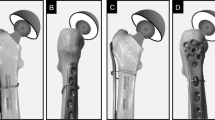Abstract
The LCP proximal femoral plate 4.5/5.0 (PF-LCP) represents a new generation of extramedullary fixation devices for stable and unstable trochanteric and/or subtrochanteric fractures. We report four cases of secondary varus collapse of the fracture with hardware failure of the implant.





Similar content being viewed by others
References
Knobe M, Münker R, Sellei RM et al (2009) Unstable pertrochanteric femur fractures. Failure rate, lag screw sliding and outcome with extra- and intramedullary devices (PCCP, DHS and PFN). Z Orthop Unfall 147:306–313
Madsen JE, Naess L, Aune AK et al (1998) Dynamic hip screw with trochanteric stabilizing plate in the treatment of unstable proximal femoral fractures: a comparative study with the gamma nail and compression hip screw. J Orthop Trauma 12:241–248
Rahme DM, Harris IA (2007) Intramedullary nailing versus fixed angle blade plating for subtrochanteric femoral fractures: a prospective randomised controlled trial. J Orthop Surg 15:278–281
Lenich A, Mayr E, Rüter A et al (2006) First results with the trochanter fixation nail (TFN): a report on 120 cases. Arch Orthop Trauma Surg 126:706–712
Brunner A, Jöckel JA, Babst R (2008) The PFNA proximal femur nail in treatment of unstable proximal femur fractures—3 cases of postoperative perforation of the helical blade into the hip joint. J Orthop Trauma 22:731–736
Strauss EJ, Schwarzkopf R, Kummer F et al (2008) The current status of locked plating: the good, the bad, and the ugly. J Orthop Trauma 22:479–486
Hasenboehler EA, Agudelo JF, Morgan SJ et al (2007) Treatment of complex proximal femoral fractures with the proximal femur locking compression plate. Orthopedics 30:618–623
Synthes technique guide “LCP Proximal Femoral Plate 4.5/5.0. Part of the LCP Periarticular Plating System.” Synthes GMBH Eimattstrasse, CH-4436 Oberdorf. Available at: http://products.synthes.com/KYO_US/kyo_us_trauma/Synthes%20North%20America/Product%20Support%20Materials/Technique%20Guides/SUSA/SUTG4.5LCPprxfemurJ4868D.pdf
Seinsheimer F (1978) Subtrochanteric fractures of the femur. J Bone Joint Surg Am 60:300–306
Müller ME, Allgöwer M, Schneider R et al (1991) Manual of internal fixation, 3rd edn. Springer, Berlin
Christ BD, Lee MA, Khalafi AK et al (2006) A comparison of percutaneous versus traditional open plate fixation in a subtrochanteric fracture gap model. In: Proceedings of the annual meeting of the Orthopaedic Trauma Association (OTA), 5–7 October 2006, Phoenix, Ariz. Basic science poster #71
Koch JC (1917) The laws of bone architecture. Am J Anat 21:177–1298
Mullaji AB, Thomas TL (1993) Low-energy subtrochanteric fractures in elderly patients: results of fixation with the sliding screw plate. J Trauma 34:56–61
Sadowski C, Lübbeke A, Saudan M et al (2002) Treatment of reverse oblique and transverse intertrochanteric fractures with use of an intramedullary nail or a 95 degree screw-plate: a prospective, randomized study. J Bone Joint Surg Am 84:372–381
Wagner R, Blattert TR, Weckbach A (1998) Solution to the problem of extra-articular, femoral hip fracture by the “sliding screw-nail principle”. Results of 2 different systems (classical nail and gamma nail). Unfallchirurg 101:894–900
Babst R, Renner N, Biedermann M et al (1998) Clinical results using the trochanter stabilizing plate (TSP): the modular extension of the dynamic hip screw (DHS) for internal fixation of selected unstable intertrochanteric fractures. J Orthop Trauma 12:392–399
Oh CW, Kim JJ, Byon YS et al (2009) Minimally invasive plate osteosynthesis of subtrochanteric femur fractures with a locking plate: a prospective series of 20 fractures. Arch Orthop Trauma Surg 129:1659–1665
Author information
Authors and Affiliations
Corresponding author
Additional information
The authors of this study did not receive any grants or outside founding in support of their research for, or preparation of, the manuscript. In addition, they did not receive payments, other benefits, or a commitment or agreement to provide such benefits from a commercial entity.
The device that is the subject of the manuscript is not approved by the US Food and Drug Administration and is not commercially available in the United States.
Rights and permissions
About this article
Cite this article
Wieser, K., Babst, R. Fixation failure of the LCP proximal femoral plate 4.5/5.0 in patients with missing posteromedial support in unstable per-, inter-, and subtrochanteric fractures of the proximal femur. Arch Orthop Trauma Surg 130, 1281–1287 (2010). https://doi.org/10.1007/s00402-010-1074-7
Received:
Published:
Issue Date:
DOI: https://doi.org/10.1007/s00402-010-1074-7




